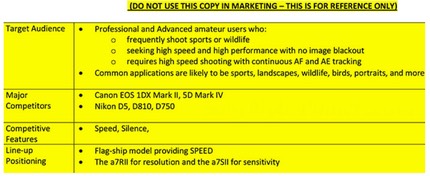The Web site sonyalpharumors posted a marketing-use only document for the new Sony A9. If this briefing document is accurate—and I believe it is—it produces a bit of head scratching for me.
Here's the document sonyalpharumors posted:

If we go back a few years, we see Sony executives outlining a strategy of "more." It started in Sony Semiconductor for sensors, but was quickly echoed by the Sony Imaging group. Essentially the sensor group started talking about sensors that had the highest resolution, the lowest light capability, the fastest bandwidth, the greatest video capabilities, and more. Sony was going to pursue these things individually at first, then in combinations as they attempted to "revitalize consumer electronics."
In looking back at some of the Sony Semiconductor presentations, I see these specific things as goals: "highest sensitivity," "lowest noise," "lowest power", "highest bandwidth," "ultra-high-speed," "widest dynamic range", and "highest pixel count."
It's not surprising that we see cameras from Sony that mirror many of those sensor goals. The A7rII targeted "highest pixel count," the A7s targeted "highest sensitivity and lowest noise," and now the A9 targets "ultra-high-speed."
But the Sony marketing document shown above is a bit odd, in that it is a bit inconsistent. I'd say the major competitors for a speed-oriented camera are the Canon 1DxII, Nikon D5, Nikon D500, and Canon 7DII, in roughly about that order. That Sony thinks that the A9 competes with the Canon 5DIV, Nikon D750, and Nikon D810 is strange.
Moreover, I see no real reason why I'd need an A9 for landscapes or portraits, which is in Sony marketing's target audience listing. The fact that "advanced amateurs" are also targeted is probably the clue that gives everything away, and I'm not sure what that says about the A7II and the A7rII. A lot of companies fall into the trap of marketing their latest product too broadly and forcefully, often at the expense of their previous products that are still available. There's a bit of that going on here. I would guess that Sony would be happy if customers bought any Sony camera, but there's a bit of an over push on "buy an A9" in what they've been doing since launch.
It seems that Sony marketing is in a bit of a slippery area here. Sony really doesn't have the lenses to legitimately claim they're going to target the 1DxII, D5, or even the D500 for outdoor sports or wildlife shooting. Speed in the camera is not useful if you can't image the subject properly. Indeed I've written articles about how I'd take less speed and the right lenses over the opposite.
That said, I'm actually looking forward to taking an A9 with the new 100-400mm to Africa, or maybe the Galapagos later in the year. It would in some ways be a repeat of my Shooting With Just a D7200 experience a couple of years ago in that it's not necessarily an optimal combination for the places I visit, but would certainly reveal just how far Sony has come.
But I digress. I find it interesting that there are only two competitive features listed for the A9: speed and silence. In most sports and wildlife photography, silence isn't really needed. There are some exceptions, like golf, but in those we don't really need the speed.
Speed—in context of the A9—appears to mostly be the 20 fps and an uninterrupted 60 fps viewfinder, coupled with a few things that a faster data stream might enable. Sony makes a claim about focus—"foolproof AF/AE while traditional SLRs can only challenge such AF/AE performance improvements"—that needs reliable field testing to even begin to be believed.
I've noted in a lot of the "viewfinder image focus" postings that have appeared on YouTube, et.al., where the boxed area being focused on has things in it that are closer to the camera than the point where I'd really want the camera focusing, and other times the closer thing is what I want the focus to move to. The results I've seen in a number of published frames from Sony's sponsored sports shooting event in New York have plenty of missed and slightly missed focus in them. In fairness, so too would the images from a D5/D500 had Nikon sponsored a similar event at those products' introduction. That's because understanding how the focus system does and doesn't work eventually leads to better capture rates.
So Sony's focus targeting and unexpected object tracking rejection really needs to be tested.
Finally, to a lessor degree, "speed" is the large buffer, though I'll reserve judgment on that until I can shoot sports directly with the A9: buffers have this tendency to look better on paper than in the camera. Indeed, there are already early reports of how slow the A9 is to empty a full buffer. I really don't understand why Sony chose SD over XQD for the card choice in the A9.
Personally, I'm hoping that Sony's A9 claims don't devolve into distracting details that need documenting. While I wouldn't currently consider an A9 a replacement for my wildlife or most of my sports photography given the current lens set, it might very well be an interesting choice for indoor sports, theater, and wedding photography, where the 24-70mm and 70-200mm f/2.8 lens come strongly into play. Indeed, I often want speed in indoor sports more than outdoor, mostly because I'm generally much closer to the action. Of the sports Sony shows in their examples on the product pages, hockey comes to mind as the one place where I'd be most interested in seeing how the A9 does. That outdoor climbing shot? Not so much. (Oh, and the golf shot they posted? Wrong. You don't need silent shooting to take that shot, and I'll bet it wasn't even taken with an A9.)
The A9 is an intriguing camera, and Sony marketing is certainly out in force trying to get who they see as the influencers to write about it.
